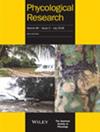高温胁迫下形成树冠的海带——双环爱森藻的基因表达
IF 1
4区 生物学
Q2 MARINE & FRESHWATER BIOLOGY
引用次数: 0
摘要
为了了解树冠型海带对高温胁迫的适应性,对日本沿海海带森林的主要组成物种——双环爱森(Eisenia bicyclis (Kjellman) Setchell (Laminariales, Phaeophyceae)进行了RNA - seq分析。我们从该物种最北端分布极限的一个种群中建立了一个培养菌株,并测量了幼孢子体的光系统II活性。我们发现光系统II活性在25°C下低于5-15°C,因此,我们对15°C和25°C下培养的双歧杆菌幼体进行了比较RNA - seq分析。与表达基因比较,在25°C下发现277个上调基因和327个下调基因。上调最多的基因是3 -酮酰辅酶a硫酶,这与脂肪酸降解有关。据报道,该酶在拟南芥(芸苔科)中正调控脱落酸(ABA)信号。此外,热休克蛋白、ATP合成酶、NADH脱氢酶和L -抗坏血酸过氧化物酶均上调。下调最多的基因是牛磺酸分解代谢双加氧酶TauD/TfdA。与脂肪酸代谢、光合作用和细胞壁成分合成相关的基因被下调。这些结果表明,双歧杆菌可能通过上调参与蛋白质稳定、能量产生和抗氧化过程的基因来对抗高温胁迫。相反,由于无法承受高温胁迫,光合作用和其他代谢过程可能受到破坏。本文章由计算机程序翻译,如有差异,请以英文原文为准。
Gene expression of a canopy‐forming kelp, Eisenia bicyclis (Laminariales, Phaeophyceae), under high temperature stress
To understand the high temperature stress acclimation of a canopy‐forming kelp, RNA‐seq analysis was performed on cultured Eisenia bicyclis (Kjellman) Setchell (Laminariales, Phaeophyceae), a major component species of kelp forests along the coast of Japan. We established a culture strain from a population at the northernmost distribution limit of this species and measured photosystem II activity in young sporophytes. We found that photosystem II activity was lower at 25°C than at 5–15°C, thus, comparative RNA‐seq analysis was conducted between cultivated young thalli of E. bicyclis at 15°C and 25°C. Comparison with the expression genes revealed 277 up‐regulated genes and 327 down‐regulated genes at 25°C. The most up‐regulated gene was 3‐ketoacyl‐CoA thiolase, which is related to fatty acid degradation. This enzyme has been reported to positively regulate abscisic acid (ABA) signaling in Arabidopsis thaliana (Brassicaceae). In addition, heat shock proteins, ATP synthase, NADH‐dehydrogenase, and L‐ascorbate peroxidase were up‐regulated. The most down‐regulated gene was taurine catabolism dioxygenase TauD/TfdA. Genes related to fatty acid metabolism, photosynthesis, and synthesis of cell wall components were down‐regulated. These results suggest that E. bicyclis may counteract high temperature stress by up‐regulating genes involved in protein stabilization, energy production and antioxidant processes. Conversely, photosynthesis and other metabolic processes may be damaged due to the inability to withstand high temperature stress.
求助全文
通过发布文献求助,成功后即可免费获取论文全文。
去求助
来源期刊

Phycological Research
生物-海洋与淡水生物学
CiteScore
3.60
自引率
13.30%
发文量
33
审稿时长
>12 weeks
期刊介绍:
Phycological Research is published by the Japanese Society of Phycology and complements the Japanese Journal of Phycology. The Journal publishes international, basic or applied, peer-reviewed research dealing with all aspects of phycology including ecology, taxonomy and phylogeny, evolution, genetics, molecular biology, biochemistry, cell biology, morphology, physiology, new techniques to facilitate the international exchange of results. All articles are peer-reviewed by at least two researchers expert in the filed of the submitted paper. Phycological Research has been credited by the International Association for Plant Taxonomy for the purpose of registration of new non-vascular plant names (including fossils).
 求助内容:
求助内容: 应助结果提醒方式:
应助结果提醒方式:


